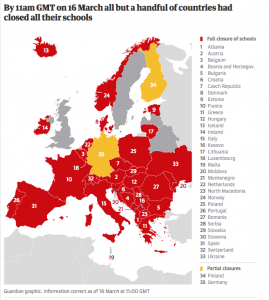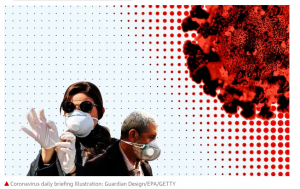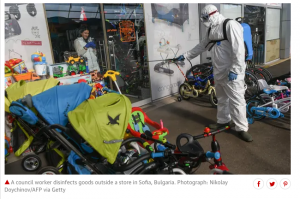Towards the end of visual capitalism
By now, as to be expected from a news situation as engrossing as this one, the compulsion to reach an (or even the) image of the pandemic (if not the world history of pandemics), is tantamount. The visual production on/of the crisis has been accelerating for weeks and has currently entered its competitive phase.

Map of European countries that have (or haven’t yet) closed their schools (The Guardian, March 16, 2020)
Photo editors and designers for news outlets such as The Guardian are constantly feeding the collective imaginary, sometimes in the form of helpful collections of visual aids to cope with the crisis, but mostly with editorial artwork deploying the key visual tropes of the moment — the “battlestar” virus and humans seeking protection from it through items such as gloves and face masks.


In addition to these standard visual responses, however, there’s a strand of creativity and inventiveness in infographics that capitalizes on the situation, using it as an opportunity to enrich and extend their portfolio. Consider the site of infographic agency Visual Capitalist, popular among World Economic Forum folks and followers. Apparently, with their “visual history of pandemics,” the people of Visual Capitalist are prepared to turn the crisis into an/their image. Visual Capitalist’s mission statement reads sufficiently self-confidently in this regard. “Visual Capitals exists for one reason – to help make this complex world a little easier to understand. Humanity generates a staggering 2.5 exabytes of data every day, and it’s becoming increasingly difficult to glean insight from the tsunami of information we’re exposed to. We cut through the spin and noise of the news cycle to highlight big picture global trends, and explore the context that gets overlooked. We use data-driven, powerful visuals to keep millions of people around the world ahead of the curve.”
This is not to say that VC should be blamed for doing what they do. Their reading, processing, and translating of the data may actually prove to be a viable contribution to the solving of the crisis. It is the competitive drive behind these enterprises in visualization that makes one wonder how they relate to all the other races (scientific, medical, technological, political, economical …) to increase insight, provide rescue, develop a vaccine, etc., as to be witnessed at the moment — while the default modes of capitalist competition are put on hold, and being suspended step by step as the crisis unfolds. Competing for the right, and that is, the most useful image in times such as these, should cease to be a race for property rights, commercialization and gatekeeping – visual capitalism (even if meant ironically, as one may suspect in the case of Visual Capitalist) has definitely reached a deadlock. TH
March 16th, 2020 — Rosa Mercedes / 02